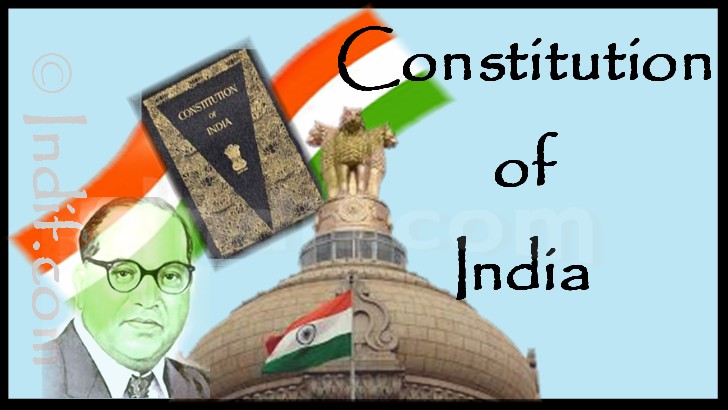What are the features of the Indian Constitution?
 |
| Salient features Constitution |
Indian Constitution
The Constitution of India was adopted by the constituent assembly on November 26, 1949. However, it comes into force on January 26, 1950. It is the product of the collective wisdom of legal luminaries constitutional pundits, statesmen, and administrators 308 in numbers. They are borrowed administrators 308 in numbers. They borrowed and opted freely from various constitutions to benefit from of government from the British Constitution, the concept of fundamental rights, the supreme court, and the institutions of the vice-president from the American Constitution. The directive principles of state policy and the structure of Rajya sabha from the Irish Constitution, The principles of current powers of legislation from the Australian Constitution, and The spirit of the centralism from the Canadian Constitution. M.P. Sharma has rightly pointed out that the object of the makers of the Constitution was not to frame on original Constitution but yet to get a good workable Constitution.
Salient features of the Indian Constitution:-
◆1.A Written Constitution:-The republic of India has a written and enacted Constitution. It contains 409 Articles, Twelve schedules, and three appendices. In it present form cover 254 octavo pages, like the construction of the united state of America, Canada, and France. India too has a written Constitution though it differs from those documents in many respects
◆2:-The longest known constitution:-
The constitution of India has the distinction of being
the most lengthy and detailed constitutional document. The world had so far produced -The original constitution contained as many as 395 articles and 8 schedules. Even after the repeal of several provisions. It still contains 409 articles and 12 schedules.
◆3.Popular sovereignty:-The constitution proclaims the sovereignty of the people units opening words. The preamble begins with the word “We the people of India, having solemnly resolved to constitute India into a sovereign, The idea is reaffirmed in several places in the constitution, particularly in the chapter dealing with elections.
◆4.Sovereign Democratic Republic:-
The preamble of the Constitutional declares India to be a sovereign democratic Republic.it is sovereign since India has emerged as a completed Independent state. The dominion status of India established under the independence Act of 1947 has been terminated and India is now a full-fledged state with all the characteristics of the sovereign.
◆5.Both Rigid and flexible:-
The Indian Constitution is partly rigid and partly flexible. The procedure laid down by the Constitution for its amendment is neither very easy as in England nor very rigid as in the united states. In England which has no written constitution, there is no difference between a Constitutional law an ordinary one. The Constitutional law can be amended exactly in the same manner in which ordinary legislation is passed or amended.
◆6:-Cabinet Government:-
The Constitution establishes cabinet type of government is complete and continues responsibility of the executive to the legislature.
◆7.Secular state:-By adding the word secular to the existing description of the country as a sovereign Democratic republic in the preamble. The commitment to the goal of secularism has been spelled out in clear terms. Alexandrovich “India as a secular state guarantees constitutionally freedom of religion to all persons and does not assign a special position to any particular religion.
◆8.A federal system with Unitary bias:-
Perhaps the most remarkable achievement of the Indian Constitution is to confer upon a federal system the strength of a unitary government. Though normally the system of government is federal. The Constitution enables the federation to transform into a unitary state.
◆9.Universal franchise without communal representation:-The adoption of universal adult suffrage without any qualification either of sex, property, taxation or the like is a bold experiment in India having regard to the vast extent of the country and its population with an over well Ming illiteracy.
◆10.compromise between judicial review and Parliamentary supremacy:-Parliamentary in India is not as supreme as the British Parliament. at the same time judiciary in India is not as supreme as in the united states of America which recognizes no limit on the scope of judicial review.
◆11.Single Citizenship:-
Although India has a federal government yet double citizenship as provided for in the U.S.constitution, has not been provided for all the Indians irrespective of their domicile united states all the citizens enjoy the right.
◆12.Independence of judiciary:-The frames of the Constitution where a Ware Democratic freedoms were meaningless in the absence of independent machinery to safeguard them.No sabordin a tear agent of the government could be trusted to be just and impartial in judging the merits of a conflict in which the government itself was a party.
◆Fundamental right:-Like the Constitution of the united states of America the construction of India also includes a separate chapter guaranteeing fundamental rights to all the citizens. These rights are justiciable and inviolable. There are binding and the legislature as well as on the executive.
◆14.Fundamental duties:-Another feature which was not in the original Constitution has been introduced by the 42nd amendment in 1976.By introducing article 51A as part IVA of the Constitution. The 42nd amendment acts as though the duties as such can not be judicially enforced.
◆15.Directive principles of State policy:-The directive principles of state policy are another distinctive feature of the Indian Constitution. This feature has been taken from the Irish Constitution. The philosophy behind the directive principles is that the state and every one of its agencies are commanded to the various filled with state activity.